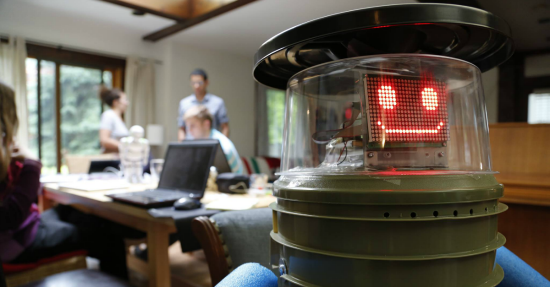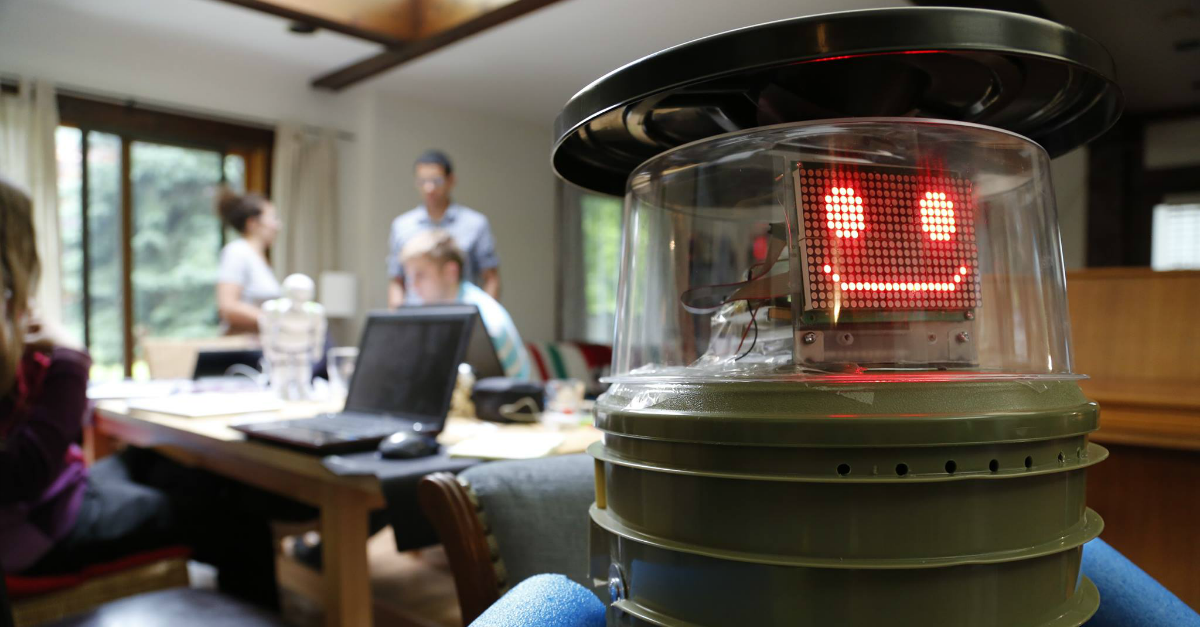
HitchBOT was on a mission to cross the United States with the help of strangers, but the hitchhiking robot came up far short of its San Francisco destination, after a vicious attack in Philadelphia, the city of brotherly love.
The three-foot-tall robot, with a beer-bucket body and a smiling LED face made it from Boston to Philadelphia, where hitchBOT met its demise early Sunday morning (2 August), apparently at the hands – and feet – of a lone vandal.
HitchBOT is the project of a pair of communications professors, Dr. David Harris Smith of McMaster University and Dr. Frauke Zeller of Ryerson University, who wanted to study how humans interact with robots in an uncontrolled environment.
HitchBOT can’t move by itself, but with an outstretched rubber thumb and instructions written on its body asking for rides from helpful humans, hitchBOT successfully traveled 10,000 km across Canada last summer, as well as throughout Germany and the Netherlands earlier in 2015.
Continuing the project, Smith and Zeller launched hitchBOT on its American tour on 17 July, embarking from the Peabody Essex Museum in Salem, Massachusetts, with a final destination of San Francisco’s Exploratorium.
The researchers’ instructions asked strangers to take the robot to some famous landmarks along the way, such as Times Square in New York City, New Orleans, and Mount Rushmore.
The solar-powered robot was equipped with Cleverscript speech technology allowing it to engage in conversation, and it shared its adventures via a video camera and social media APIs that transmitted messages with followers on Twitter and Facebook.
On Sunday, hitchBOT’s social media accounts announced that the project had reached an end “for now.”
Typically when we talk about artificial intelligence, the question on people’s minds is: can robots be trusted not to take our jobs, kill us without remorse, or enslave us as their pets?
Instead, say the pair of Canadian researchers, we should be asking whether robots can trust humans.
The answer to that question is a bit murky.
Surveillance footage obtained by Philadelphia video artist Jesse Wellens, who filmed himself interacting with hitchBOT outside of the Philadelphia Museum of Art, appears to show the “murder” of hitchBOT.
Although we can’t see hitchBOT in the black and white surveillance video (it’s hidden behind a post office box), the video shows a male wearing a backwards baseball cap and Philadelphia Eagles jersey ripping off what looks like hitchBOT’s foam arms, and repeatedly punching and stomping the robot.
This surveillance camera footage from Philadelphia’s @Jessewelle is thought to show hitchBOT’s violent demise. https://t.co/37EzUHUqnq
— CBC News (@CBCNews) August 4, 2015
But if anyone’s tempted to dismiss the entire human race (or Americans generally and Philadelphians specifically) as a lost cause due to the actions of a lone thug, there’s evidence for our kindness and perhaps a chance at redemption.
An outpouring of support from hitchBOT fans included offers from people in the Philadelphia tech community to repair hitchBOT and allow it to resume its travels.
Members of the maker collective The Hacktory have proposed building a new robot to carry on hitchBOT’s lesson.
And fans organized a trip to retrieve hitchBOT’s broken body and send it back to its creators.
Smith and Zeller said on hitchBOT’s website that the experiment is not over:
We know that many of hitchBOT's fans will be disappointed, but we want them to be assured that this great experiment is not over. For now we will focus on the question "what can be learned from this?" and explore future adventures for robots and humans.
So, what can we learn from hitchBOT?
Perhaps this story can teach us a lesson about our capacity for good and evil – to do great harm, but also perform acts of love and forgiveness.
My trip must come to an end for now, but my love for humans will never fade. Thanks friends: http://t.co/DabYmi6OxH pic.twitter.com/sJPVSxeawg
— hitchBOT (@hitchBOT) August 1, 2015
When it comes to compassion, at least, robots haven’t yet eclipsed humans.
Image of hitchBOT via Facebook.

Anonymous
Video is a fake
John Zorabedian
You’re right to doubt it. The hitchBOT creators said in a press release today (5 August) that the video was a fake.
We still don’t know who destroyed the robot, but the researchers now say it will be back in 2016 to resume its journey from Philadelphia.
Their full statement is here (PDF):
http://cdn1.hitchbot.me/wp-content/uploads/2015/08/hitchBOT-USA-Trip-End-Press-Release-FINAL.pdf
Techno
I understand that the video is thought to be a fake. Apparently there is no CCTV camera at that location, the quality of the video is surprisingly good, and the robot cannot actually be seen. News reports are that the robot was found without its head, but the video doesn’t show the vandal stealing the head. The vandal is also dressed like Wellens (so I understand).
I find it interesting that it travelled successfully across Canada and Europe but barely made it anywhere in the USA. It does seem to reinforce the common opinion that other countries have more of a shared social responsibility and are less violent that the USA.
Paul Ducklin
On a point of order – “making it across the Netherlands” (which I understand the robot did), say from Eindhoven to Groningen, is about 250km. In contrast, Boston to Philly, for all that it seems like “barely making it anywhere” in the USA, is about twice that distance and takes in a population that’s as least as big. (Boston + New York City + Philadelphia alone contain about as many people as all of the Netherlands)
So…careful of those comparisons. It’s easy to mix up your units :-)
Elbyem
The population is about 30 million: and it’s about 3000 miles across Canda, which the robot navigated with no difficulty whatsoever. So – what’s your point?
Paul Ducklin
Actually, it seems that the robot covered 10,000kms on its Trans-Canada leg. But it also covered a journey “across the Netherlands,” which is my point of comparison. (The OP mentioned its European trip, not merely its Canadian one.)
Anyway, if you are looking for evidence that the USA is “more violent” or “less socially responsible” than, say, Europe, then this is the wrong way to go about it, and not just because you are working with a sample size of 1.
Anonymous
You are right and Canada’s population is only something like 35 million, so it is not a direct comparison. Beating it up wasn’t very creative. I think it should have showed up in the Republican debates or in Hillary Clinton’s press pool. If it was beheaded, the culprit may have been the lion killing dentist.
R2D2
Frankly, the whole thing teaches us nothing. Coming across one lone vandal (if it was one…as there does seem to be doubt about that video) says nothing about the US as neither does making it successfully across Canada say anything about their population. (Ditto Germany and Holland). The whole experiment was flawed and I’m guessing was more about the publicity than serious science.
Anyway, my mum always told me hitchhiking was dangerous…
G-Man
Hitchbot probably shouldn’t have been wearing that Cowboys jersey :). Philadelphia: The city of brotherly thugs.
Mr. Robot
#RobotLivesMatter
Anonymous
“Some’s bastards, some’s ain’t. That’s the score.”
― Jack Kerouac, On the Road
Bart
I disagree with the preferred question of the two researchers; rather, that this shows what underpaid American workers think of welcoming robots into their lives.
Laurence Marks
John Zorabedian wrote “So, what can we learn from hitchBOT?”
What? Well, Version 2.0 needs tasers in both arms, for a start,
gregory flattery
Breaking News……………hitchBOT holds Press Conference
Quote ” I’ll Be Back “.
TonyG
Interesting the questions about humans and robots. How does this compare to the questions about the start of the industrialisation when we had the Luddites destroying machinery?
Undoubtedly industrialisation had its downsides, but the eventual benefits far outweighed those. Without industrialisation, Facebook would be people transcribing notes, posting them everywhere and carrying them from town to town. Hmm – maybe there is something to pre-industrialisation after all :-)
AshleyGH
Anyone who is not tempted to dismiss the entire human race Philadelphians specifically is a lost cause. You’re talking about a city that complained when they were not a 9/11 target, behavior like this is no surprise.
redsoxaddickt
i read about “hitch” in my local newspaper the other day and i am quite surprised that he only made it to philadelphia. the kerouac quote was accurate. the roger waters song “the pros and cons of hitchhiking” also comes to mind
Peter
Hitchbot was not a robot! It was a trash can with a cellphone inside. The “arms” and “legs” were just ornaments. If I left it out on my curb in the morning the municipal trash people would have hauled it away before I returned home from work.
If anything, it was probably torn apart by a real robot who resented it stealing the name “robot” for a useless piece of trash.